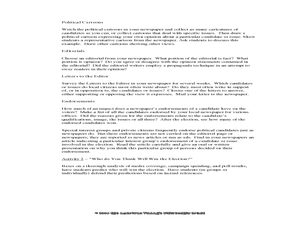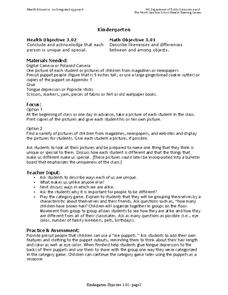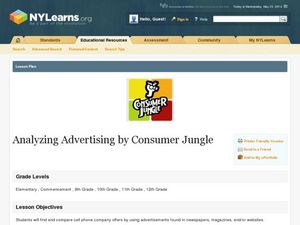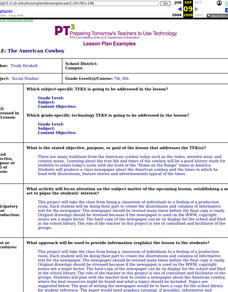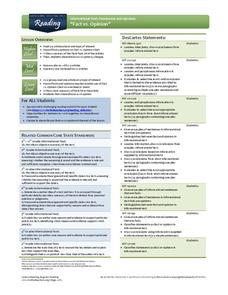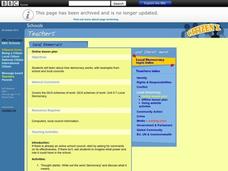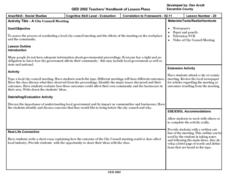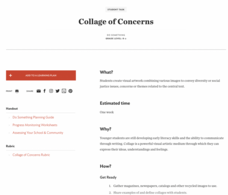Sargent Art
Improvisation: Dada and Surrealism
Images of works by Salvador Dali, Luis Bunuel, and Man Ray launch a study of Dada and Surrealism. After critiquing works by these and other artists, class members gather their own images and arrange them into a cohesive composition.
Curated OER
ADULT ESOL LESSON PLAN--Skills Necessary to Listen, Speak, Read and Write Effectively
Students, referring to the alphabet and numbers, practice stating, reading and writing letters and numbers. As they write each letter and number they say each one as well. They find examples of each one in a newspaper or magazine ad.
Curated OER
The Gettysburg Address (1863): Defining the American Union
Learners explore the Gettysburg Address. In this U. S. history lesson, students examine Abraham Lincoln's speech and it's themes of freedom, equality, and emancipation.
Curated OER
Brainstorming Time
Students brainstorm a list of possible topics for their essay. As a class, they review the characteristics of anecdotal writing and the form they take in newspapers or autobiographies. To end the lesson, they decide on their topic for...
Curated OER
The Electric Hearth
Students examine popular media. In this media awareness lesson plan, students keep logs of their interactions with media and then write an essay regarding the data.
Curated OER
Publishing a Newspaper about Biomes
Young journalists create newspapers of individual biomes after researching their biomes. This instructional activity can be completed in three phases and concludes with each person publishing their individual newspaper pages.
Curated OER
The Campaign: Issues and Strategies. What do you think?
Young scholars research a candidate in an election and discuss how the media portrays that candidate and how the media influences voters. In this candidate lesson plan, students also distinguish fact from opinion, look at political...
Curated OER
Mannequin
Students create an outfit out of newspaper and masking tape to be placed on one of their classmates. In this outfit lesson plan, students have 10 to 20 minutes to complete the getting to know you activity.
Curated OER
I Am Special
Students conclude and acknowledge that each person is unique and special. In this I Am Special lesson plan, students compare their digital photograph to pictures of people in magazines to determine likenesses/differences. They describe...
Curated OER
Piecing Together the Story of Glenn Cunningham: A Kansas Champion
Students use primary and secondary sources to conduct research about Glenn Cunningham. In this Glenn Cunningham lesson plan, students tell why he was a hero, and tell facts from what they learned.
Curated OER
Nutrition Awareness
Students gain an awareness of nutrition. In this science lesson plan, students explore how to determine his or her ideal body weight, demonstrate familiarity with the food groups relating to kilocaloric content, estimate the basic...
Curated OER
Health Education: An Integrated Approach
Second graders advocate to others the dangers associated with excessive sun exposure. In this health lesson plan, 2nd graders participate in an experiment in order to identify methods for protecting themselves from the sun.
Curated OER
Natural Selection
Students research examples of Natural Selection on a website provided by the teacher. They experiment in groups, different processes of Natural Selection and list them on a chart provided in this lesson plan
Curated OER
Report on a Reporter
Students listen as a local reporter visits their classroom. They write them a thank you note and develop their own questions to ask them. They practice using proper sentence structure and grammar.
Curated OER
Analyzing Advertising
Some ads really make products look great, and even better than they really are! Kids get into small groups to research and compare marketing used by various cell phone companies. They analyze advertisements, carrier options, and cell...
Curated OER
Conventions - Punctuation Research
Study unusual punctuation marks in this punctuation lesson. Young grammarians work in small groups to research one of the unusual punctuation marks (semi-colon, colon, dash, comma, ellipses, or quotation marks) and discuss how the mark...
Curated OER
The American Cowboy
Middle Schoolers produce a class newspaper about the American cowboy and the times in which he lived with illustrations, feature stories and advertisements typical of the times. This is an ambitious, yet worthwhile project for youngsters...
For the Teachers
Fact vs. Opinion
Many informational texts are written as factual, but can your learners determine when an opinion is presented as fact? Have your kids read several articles on the same topic and record the statements that contain either facts or...
Curated OER
Drug and Alcohol Awareness
Fourth graders examine the statistics when it comes to teens and drug and alcohol abuse. In groups, they research the side effects of four different drugs. Using the information, they perform a skit, or puppet show to share their data...
BBC
Local Democracy
Middle and high schoolers explore how democracy works. After a teacher-led discussion, pupils go to websites embedded in the plan which lead them through activities that are all about the democratic process. The first website has them...
Curated OER
A City Council Meeting
Here is an interesting plan for introducing your pupils to the workings of the local city council. The teacher must go videotape a city council meeting in it's entirety. Learners watch the tape, and discuss what they observed from the...
Curated OER
Fact Or Opinion
Groups of junior highers find newspaper articles which contain both facts and opinions, and present examples of each to the class. The focus is on discerning between fact and opinion. Two excellent worksheets are embedded in the plan...
Teaching Tolerance
Collage of Concerns
A picture can speak louder than words. An interesting lesson introduces the themes of social justice and diversity to young learners by having them create artwork. Scholars create collages from a variety of sources to showcase what...
Newseum
Believe It or Not? Time to Talk Back
Young journalists select a news story, editorial, or opinion piece that they disagree with or one that leaves them with questions. They then create their report in response and share it with the class.








